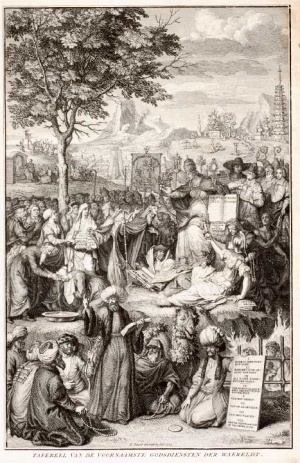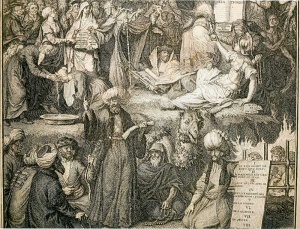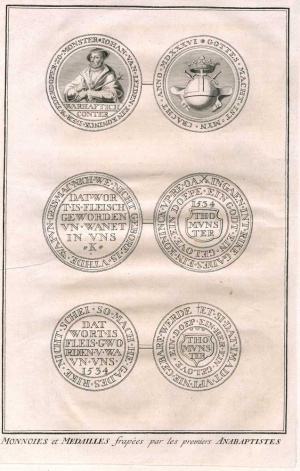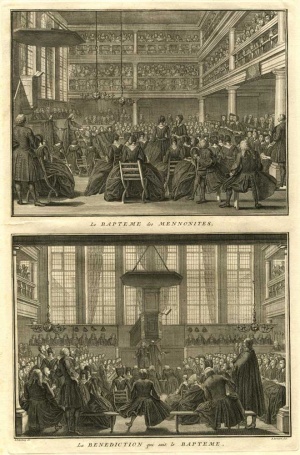Difference between revisions of "Picart, Bernard (1673–1733)"
| [unchecked revision] | [unchecked revision] |
GameoAdmin (talk | contribs) (CSV import - 20130816) |
GameoAdmin (talk | contribs) (CSV import - 20130820) |
||
| Line 1: | Line 1: | ||
| − | + | [[File:Bernard_Picart-_after_Jean-Marc_Nattier.jpg|300px|thumb|right|''Bernard Picart after a painting by Jean-Marc Nattier | |
(1709). Wikimedia Commons | (1709). Wikimedia Commons | ||
| Line 29: | Line 29: | ||
'']] [[File:Picart_Bernard_p208.jpg|300px|thumb|right|''Facing p. 192 Facing p. 202 Facing p. 207 Facing p. 208 | '']] [[File:Picart_Bernard_p208.jpg|300px|thumb|right|''Facing p. 192 Facing p. 202 Facing p. 207 Facing p. 208 | ||
| − | '']] <tr> <td><span class="style1">Facing p. 207</span></td> <td><span class="style1">Facing p. 208</span></td> </tr> | + | '']] <tr> <td><span class="style1">Facing p. 207</span></td> <td><span class="style1">Facing p. 208</span></td> </tr> |
= Bibliography = | = Bibliography = | ||
Hunt, Lynn, Margaret C. Jacob and Wijnand Mijnhardt. <em>The book that changed Europe : Picart & Bernard's Religious ceremonies of the world</em>. Cambridge, Mass.: Belknap Press of Harvard University Press, 2010. | Hunt, Lynn, Margaret C. Jacob and Wijnand Mijnhardt. <em>The book that changed Europe : Picart & Bernard's Religious ceremonies of the world</em>. Cambridge, Mass.: Belknap Press of Harvard University Press, 2010. | ||
| − | Picart, Bernard. <em>The ceremonies and religious customs of the various nations of the known world</em> [electronic resource]. Farmington Hills, Mich.: Thomson Gale, 2003. | + | Picart, Bernard. <em>The ceremonies and religious customs of the various nations of the known world</em> [electronic resource]. Farmington Hills, Mich.: Thomson Gale, 2003. |
| − | |||
| − | |||
= Additional Information = | = Additional Information = | ||
<em>The Origins of Comparative Religion: Bernard and Picart's Religious Ceremonies and Customs of All the Peoples of the World (1723-1743). </em>UCLA Digital Library Program. Web. 8 December 2012. [http://digital2.library.ucla.edu/picart/index.html http://digital2.library.ucla.edu/picart/index.html]. | <em>The Origins of Comparative Religion: Bernard and Picart's Religious Ceremonies and Customs of All the Peoples of the World (1723-1743). </em>UCLA Digital Library Program. Web. 8 December 2012. [http://digital2.library.ucla.edu/picart/index.html http://digital2.library.ucla.edu/picart/index.html]. | ||
| − | |||
| − | |||
{{GAMEO_footer|hp=|date=December 2012|a1_last=Wiebe|a1_first=Victor G|a2_last=|a2_first=}} | {{GAMEO_footer|hp=|date=December 2012|a1_last=Wiebe|a1_first=Victor G|a2_last=|a2_first=}} | ||
Revision as of 19:26, 20 August 2013
Bernard Picart (Picard): French engraver, was born 11 June 1673 in Paris, France to Etienne Picart (1632-1721), also an engraver and one of his teachers. As an artist and engraver Bernard's talents developed rapidly and at age 16 he gained honors at the l'Academie Royale de Peinture et de Sculpture in Paris, France. Bernard moved to Antwerp in 1696. Next he spent a year in Amsterdam before returning to Paris at the end of 1698. He married in 1702, but his children and finally his wife all died by 1708. In the next several years he lived in Antwerp, The Hague and Amsterdam (in 1711) where he was later joined by his father. In 1712 he married Anne Vincent and remained in Amsterdam until his death on 8 May 1733.
The majority of Picart’s work was copper engravings to illustrate books. The greatest acclaim came for his French language, highly illustrated Cérémonies et coutumes religieuses de tous les peuples du monde, appearing 1723-1743 in seven volumes, and with supplements eventually reaching 12 volumes. Three years later a Dutch edition was titled Naaukeurige beschryving der godtsdienst-plichten, kerk-zeden en gewoontens van alle volkeren der waereldt and an English edition called: Ceremonies and religious Rites of the various nations of the known world..., published beginning in 1733 and in German as: Heilige Ceremonien, Gottes- und Goetzen-Dienste aller Völcker der Welt: oder eigentliche Vorstellung und summarischer Begriff der vornehmsten Gottes-dienstlichen Pflichten.Nach des berühmten Picarts Erfindung in Kupfer gestochen, in 1746. The work was celebrated in its day and often reprinted, pirated, and plagiarized in multiple editions and languages for many decades after. A Dutch facsimile edition was published in 1968.
Cérémonies, which contained over 3,000 pages of text and more than 250 engravings, was a prodigious effort to record the religious rituals and beliefs of the many peoples of the known world in all their diversity as objectively and authentically as possible. The work was an early testimony to religious toleration for it presented all religions as even-handed as possible, and served as an early witness to comparative religions. Although Picart never left Europe; he relied on accounts and artefacts by those who had. In Amsterdam Picart became a Huguenot convert, and partnered with another Huguenot refugee, the bookseller Jean-Frédéric Bernard. Though uncredited, J-F. Bernard wrote most of the scrupulously footnoted text that complemented the engravings. All the engravings were designed by Picart but he was assisted by his seven students and several other accomplished engravers.
Frontispiece of of Cérémonies Section of Frontispiece showing Menno Simons (upper left) Mennonites were featured in volume 6 of this important work. For example Picart’s frontispiece illustration, depicts a vast array of people demonstrating their different religious practices. Included at the left centre of this illustration is Menno Simons. The text at the bottom of the Dutch edition described Menno in the engraving as: “... a Quaker with his hat on his head who is next to Menno Simons baptizing an adult. Simons is the head of the Mennonites, who are derisively called Anabaptists.”
Volume 6, pages 187-208, of Cérémonies described Anabaptists, Hutterites, and Mennonites in a forthright manner though the focus in the text is on revolutionary Anabaptists such as Melchior Hoffman and the Münsterites. The text chided Anabaptists for inconsistencies such as being violent though proclaiming peace. The portion on Mennonites noted their emphases on peace, separation from civic duties and non-participation in war. It includef extensive quotations from both the Dordrecht Confession of Faith and from Galenus Abrahamsz de Haan’s Verdédiging der Christenen (Defense of Christians). This was followed by a description of Amsterdam Mennonites' procedures in baptism and communion which were depicted in accompanying engravings.
Four folio sized copper engravings, about 22 x 35 cm. in size, were inserted in this text. Facing page 192 was an illustration titled: Monnoies et Medailles frapées par les premiers Anabaptistes, showing both sides of a commemorative medal of revolutionary Anabaptist Jan van Leyden and the two commemorative coins that Anabaptists minted in 1534 in their city of Münster, Germany. Facing page 202 the engraving showed four images on one plate: an Anabaptist man from East-Friesland in upper left panel and another Mennonite man of Amsterdam in the lower right panel, and a Quaker man and woman. Facing page 207 was the engraving Le Bapteme des Mennonites, giving two views of a Mennonite adult baptism ceremony held in the Lamist (Kerk by ‘t Lam) Mennonite Church, Amsterdam, now known as the Singelkirk engraved by Balthasar Bernaert in 1732. Facing page 208 the engraving was titled La cene des Anabaptists premiere figure and depicted two scenes of Mennonites in the same Laminist Amsterdam church taking communion.
The wealthy Mennonite silk merchant Pieter Teyler van Hulst was inspired by the book to designate in his testament the funding and establishment of Teylers Stichting (Teylers Foundation) with the Teylers Eerste Genootschap (Teylers First Society) which focused on the promotion of natural religions.
Facing p. 192 Facing p. 202
Facing p. 207 Facing p. 208
Bibliography
Hunt, Lynn, Margaret C. Jacob and Wijnand Mijnhardt. The book that changed Europe : Picart & Bernard's Religious ceremonies of the world. Cambridge, Mass.: Belknap Press of Harvard University Press, 2010.
Picart, Bernard. The ceremonies and religious customs of the various nations of the known world [electronic resource]. Farmington Hills, Mich.: Thomson Gale, 2003.
Additional Information
The Origins of Comparative Religion: Bernard and Picart's Religious Ceremonies and Customs of All the Peoples of the World (1723-1743). UCLA Digital Library Program. Web. 8 December 2012. http://digital2.library.ucla.edu/picart/index.html.
| Author(s) | Victor G Wiebe |
|---|---|
| Date Published | December 2012 |
Cite This Article
MLA style
Wiebe, Victor G. "Picart, Bernard (1673–1733)." Global Anabaptist Mennonite Encyclopedia Online. December 2012. Web. 16 Apr 2024. https://gameo.org/index.php?title=Picart,_Bernard_(1673%E2%80%931733)&oldid=83883.
APA style
Wiebe, Victor G. (December 2012). Picart, Bernard (1673–1733). Global Anabaptist Mennonite Encyclopedia Online. Retrieved 16 April 2024, from https://gameo.org/index.php?title=Picart,_Bernard_(1673%E2%80%931733)&oldid=83883.
©1996-2024 by the Global Anabaptist Mennonite Encyclopedia Online. All rights reserved.





